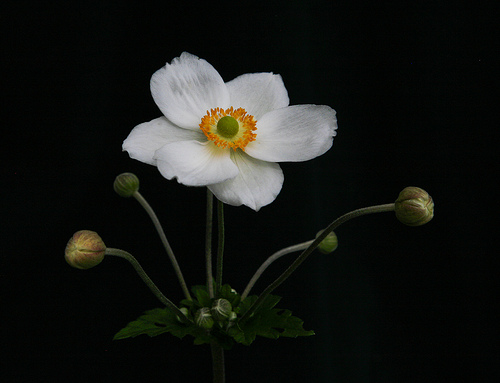Eric’s Pet Plant – Japanese Anemone

One of my favorites! For trouble-free late fall bloom on a plant that’s lovely all summer long, I’m with Eric in finding it among the best.
Japanese Anemone
(Anemone x hybrida)
By Eric Larson
November 13, 2009:
Blooming in our landscape: Vinca minor, sporadically. Winter jasmine (Jasminum nudiflorum) is covered in blooms (if indeed it ever could be: they are sparse bloomers by nature). Camellia x ‘Winter Snowman’ has been putting on a real show in our protected Meditation garden. There was a rose blooming very fragrantly last weekend in a neighborhood near me in Hamden. Dandelions have sent up exploratory yellow heads in the last few days, as if to say “This global warming stuff isn’t so bad, really.” There is a Dahlia still perking along in the sunny border near the Camellias. Then there are lots of plants with berries. And there are the sedheads of the anemones.

The fuzzy white seedhead of Anemone x hybrida attracts attention long after the flowers have disappeared.
Our small patch of Japanese Anemones really likes it where we planted it, on the north side of greenhouse 1b, where it gets plenty of reflected and diffuse light. They will tolerate full sun, but they tend to be more prone to drying out, which stresses a plant.
Our plants get more than their share of rainfall, as that greenhouse structure has no gutters on it, so the plants get not only the rain that falls within their drip-line, but also the watershed up to the peak. I was careful in my plant selection for this area, to account for that one hydrological fact.
Japanese Anemones prefer a moist humus-rich soil, which is also exactly what we have given ours. This plant is at its best when given enough room to expand a bit, so plant them eighteen inches apart and a good two feet from other plants in the area. They will spread by underground runners. I have heard people claim that this Anemone is a ‘thug,’ but I can forgive a thug who is so charming.

The plant itself, which gets three feet high by four or more feet wide
Anemone x hybrida is a member of the Ranunculus or Buttercup family (Ranunculaceae), which comprises over 50 genera and 2500 species, all herbaceous plants. It is in bloom from late summer into October. Indeed ours is done, but the seed heads are also ornamental, extending the season of interest. The flowers are pink to white, not very fragrant if at all, but much beloved by bees: what the plant lacks in nectaries, it makes up for in pollen I guess. The flowers are held above the foliage on long stalks, with six to twelve buds on each one. The sum result looks like a cloud of butterflies shimmering in a breeze.
The genus name Anemone is from the Greek word anemos for wind ; giving it pride of place among the several genera that share the common name Windflower. There are over a hundred species in the genus; ours is a mixed-up mélange that took years and countless accidents to produce. Our plant is specifically A. x hybrida ‘Honorine Jobert,’ a vigorous hybrid discovered growing in a garden in Verdun, France in 1858. It has white flowers.
For late summer bloom, carefree growing and interesting seedpods, you can’t go wrong with the Japanese Anemone, available through mail order or from your local nursery.
A word about ‘big box stores:’ Although the prices seem good, there is always risk in relying on such purveyors when buying plants. Mass-produced, trucked all over the country, handled with less than delicate care, indifferently cared for at the store, these plants are prone to be root-bound, poor condition plants. So buyer, beware!
Disclaimer: The opinions and views expressed herein are the sole responsibility of the author. Yale University and Marsh Botanical Garden and Leslie Land are not responsible for the inane and sometimes off the chart craziness of this publication
Anemone flower close up by Hellsgeriatric on flickr.
A shopping note from Leslie: Japanese anemones are widely available mail-order and they are not ( or should not be except in the case of rare cultivars) expensive plants. Don’t be afraid to save money by buying small ones; if they like it where you plant them they will be large almost before you have a chance to put away the trowel, and if they don’t like it being big won’t help.
.















One of my favorites. I love Japanese Anemones and indeed, Honorine Jobert is about the best white!
Another beauty is the silvery pink September Charm. I tend to like the singles better than the doubles.
Does anyone have a mail order source for September Charm? I’ve seen pictures and think they’re so pretty but haven’t ever seen them in the stores in my area . . . Zone 5, NE
Thanks
Hi Roxanne
I was just avoiding going to work by browsing through the Forestfarm catalog. Remembered your query. They’ve got ’em – along ( as usual) with several other tempting choices.